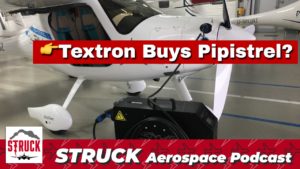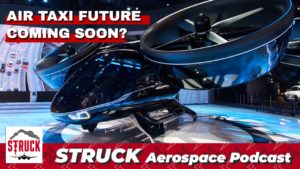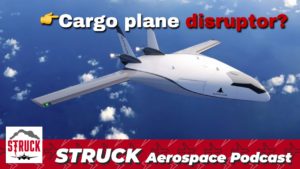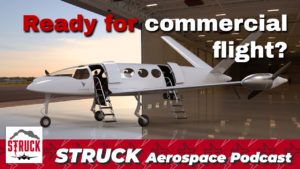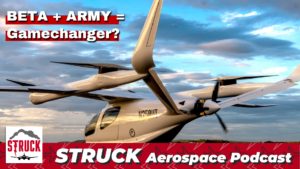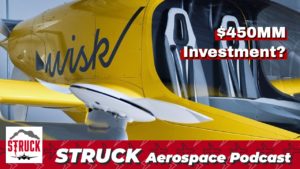The Kittyhawk Heaviside EVTOL aircraft is impressive, and has been flying recently and making headlines. But with an engineering team that is very small, will they actually have the staff to get it to market? Blue Force Technologies is a leader in carbon fiber, and they have some techniques that seem to be pushing the industry to new limits. We also discuss the VoltAero Cassio hybrid electric aircraft, Airbus deliveries surging and a commercial airliner caught in a terrible hailstorm that shattered the windshield.
Learn more about Weather Guard StrikeTape segmented lightning diverter strips. Follow the show on YouTube, Twitter, Linkedin and visit us on the web. Have a question we can answer on the show? Email us!
Podcast: Play in new window | Download
Transcript: EP31 – Will the Kittyhawk Heaviside EVTOL Actually Reach the Market? Plus Blue Force Composites New Carbon Fiber Molding Techniques
You’re listening to the struck podcast I’m Dan Blewett I’m Allen hall and here on struck we talk about everything aviation aerospace engineering and lightning protection all right welcome back to the struck podcast this is episode 31. on today’s show in our news segment we’re going to chat a little bit about airbus so they’ve got uh an increase in deliveries this past month month which is uh great to see number two a really scary moment a hail storm uh cracked a windshield of a recent flight and we’re gonna talk a little bit about covet and the odds of getting it uh on a flight so it seems like it’s actually quite low which i think all of us or a few of us would have predicted many many months ago when we’re you know still in the grips of the uncertainty of it all but some new data is pretty interesting suggesting that you’re pretty unlikely to catch on a flight in our engineering segment we’ll talk about blue force composites some of the interesting work that blue force technologies is doing and we’re going to talk about the VoltAero Cassio which is a quirky hybrid electric aircraft and then lastly in our EVTOL segment we’re going to talk about the Kittyhawk Heaviside which is flying and they’re kind of making some waves recently but I think Allen’s got some strong views here on the overall scope of the EVTOL certification process and whether some of these companies are actually going to make it to the finish line so Allen let’s start with airbus deliveries are up this makes you excited i’m sure yeah it’s good to see some airplanes being delivered for once uh airbus sold about 57 airplanes in september uh i’m sure exactly 57 – 57 it’s an easy number to remember uh that they’re probably clinking the shame champagne glasses and toulouse because that is a decent number that’s the highest number it’s been all year and i think they’re hoping that it continues to rise uh that’s in comparison to Boeing’s 11 aircraft sold in september so there’s a five to one difference between Boeing and airbus which i’m sure makes Toulouse excited to hear that uh but it does i think that the bigger picture here is that aircraft sales and deliveries are not so much sales but deliveries are starting to happen and there’s a small but growing demand for aircraft i think that will continue as we start to come on the back side of COVID even though it doesn’t feel like it i think uh for the most part there is a big uh positive change in covet and with vaccines coming relatively soon i think we’re gonna be looking forward and hopefully some of these airlines are looking forward to and start picking up some airplanes because when the demand hits people will gonna go on vacation i i don’t know how they’re not gonna go on vacation after being stuck in their homes for literally a year i think there’s gonna be a lot of travel once everybody feels comfortable they’re gonna get out and they’re gonna spend some money and the airlines want to be ready for that yeah well it says the bulk of the delivery so 43 of the 57 were a320s which is narrow body yep but question for you i know very little about airplane deliveries but why is anyone buying new aircraft right now i mean couldn’t they delay i mean is this really such an urgent need like who’s buying who’s buying planes right now well airplanes go out of service for a multitude of reasons because a lifetime has expired because they burn too much fuel because it’s just not worth putting more money into them that’s most likely the case if you can save enough money on fuel because you’re using the the newer a320 which has better engines on it then you will make that change because a lot of and some of these aircraft may be going out to lease which is another uh valid marketplace in these tumultuous times that leasing an aircraft probably makes a lot of sense so the leasing companies are being able to to uh you know leash an aircraft for a while and if if you don’t need it you can return it sort of thing uh just like a car yeah so i i think there’s that sort of uh weird marketplace that’s happening now but you do swap airplanes quite frequently if you go look at the aircraft bone yards though the aircraft graveyards they’re full of airplanes and and there’s a cycling through even a company like southwest which is all 737s they do take those older 737s out of service and put the newer ones in because they’re much more efficient they have all the the fancy upgrades you got the uh more amenities to them they have they’re much more efficient so it makes sense to to take the old ones out of service so speaking of a320s there was a flight out of chicago recently united airlines flight that had to make an emergency landing i mean they just right off right out of uh the gate pretty much i mean they made a loop over lake michigan after leaving chicago came back but this photo is crazy they had a shattered windshield from hail which i’ve never heard of that before i mean you think of you know planes being insulated from all this stuff i know we’ve talked about bird strikes a bunch on the show but yeah some passenger i guess they’re just walking out or maybe there’s a crew member but i mean the windshield looks shattered just like you know if you took a huge rock to your car windshield like it just looks the same which surprises me i think it surprised me for two reasons one i kind of assume they’re made of like a polycarbonate that just could not possibly be shattered but then i guess the you know with hail or just with the particulate in the air and the high speeds that would probably make them very cloudy to see through is that is that right well they’re made of multiple layers if you actually uh were to see an aircraft windshield especially a jet windshield that there there are multiple layers involved there they’re combination of glass and what i would consider like a bonding agent between the layers such that you can break the outer layer and the the remaining layers can handle the pressurization loads and aircraft loads which are minimal but i mean the pressurization loads are the big one without bursting right your worst case scenario is it lets go and the airplane depressurizes and bad stuff happens so they’re designed to take that and birds also right so they have to also take birds running into them which happens quite often and keep on flying so the hail to me the hail thing is more of an issue of what were the pilots doing flying into a hail storm you have weather radar on those airplanes which should be able to discern for the most part discern where severe weather patterns are and you want to avoid those if you see red on the weather radar screen those are places which may have hail and you probably want to stay away from those why you fly into that i don’t know i know it seems to happen most of you don’t take off a landing right where they’re trying to get out of someplace or get into some place a little bit of a rush to get in and out they think and squirt between two two parts of a storm and get between these two red cells which is what typically it looks like on the screen uh so you’re trying to split the difference and get through there before the aircraft get things up but it’s dan it’s just like if you’re in kansas in uh april and you there’s hail big hail storms out there you don’t go driving towards a thunderstorm man you can see that thing out there and it’s just going to dent the heck out of you it’s not just going to break the windshield it’s going to damage the leading edges it can and severely damage the engines which are all designed to take some level of hail but structurally man you just dent the heck out of that airplane and composite panels anything that’s a carbon fiber panel a fiberglass panel a fairing and whatnot man that the impact damage to those can be really a pain in the backside to go find and and to evaluate so for that 30 second excursion a lot of repairs man a lot of repairs so speaking of commercial flights man everything in the show is just really flowing together right now alan uh kovid is not really much of an issue on planes which again i think is probably you know if we were to say that we go go back in time and tell people this back in april or may they’d be like you’re crazy but some interesting data um so i guess uh dr powell of the iata uh you know he’s got some peer-reviewed literature says 1.2 billion passengers have flown and 44 people have been confirmed to have caught covet from another flyer so that essentially means one case out of every 27 and change million travelers and that’s actually higher than being struck by lightning which your risk in the us’s one in every 1.2 million people so pretty interesting definitely counterintuitive and in this article from simpleflying.com they have a nice little graphic that kind of explains the difference and this was i guess some stuff from airbus but as we’ve talked about before cabin air is fully renewed and you know sent out every two to three minutes there’s a constant injection of fresh air they have great filters and there’s there’s air flowing bottom to top and just sort of taking all this stuff out so with masks even in close quarters with every seat occupied it’s it’s a pretty safe experience does that seem accurate i think it’s very accurate having taken a number of flights over the last couple of months i would say that’s extremely accurate and it it mirrors what i have seen up close which is a couple of things people are not talking on those airplanes and if the the major source of transmission is uh speech which is spraying water droplets it seems to be the bigger big risk in in the covet discussions people are not yelling and screaming on an airplane they’re pretty much quiet watching a movie reading a book not saying anything with a mask on the whole time so the exposure seems relatively small and there is not a soul on the airplane that’s coughing wheezing sniffling anything of the sort because it’s going to immediately take a flight attendant to you to ask what’s going on shut up and fly sir no talking shut up and fly yeah right um right everybody’s thinking the same thing this is america you’re not a lot of cough these days you know that well which is funny like i i’ve had the most remarkably amazing allergy-free year of my life i’ve been a very allergy full person if that’s a word i’ve had a great coming you know me moving back to the east coast just a year ago i’ve had a great time with my allergies like i haven’t had even a sniffle but recently when i put my mask on i feel like it has some effect especially when i like exercise a little bit and have to put my mask back on i feel like it’s causing me to get a little bit sniffly i don’t know if it’s like circulated heavy very moist air whatever it is but i’ll like put my mask on sometimes and i’m like start to get a little bit like sneezy and i’m like nothing’s changed except for the mask being on and me breathing heavy into it so i was doing some baseball stuff last night and you know i have the mask on the whole time and the times i’m like running around and doing a little bit more i start to get a little sniffly and so there’s clearly some effect with like the recirculated air within your mask which yeah i actually do have a flight plan in the next month so i got to be able to be make sure they’re all cl cleaned up i got fresh masks so anyway but these are i mean these are good numbers and hopefully you know americans start to get their um trust back in flying or just really have somewhere to go i think that’s part of it right now is like where is anyone gonna go with a lot of stuff being happy half open and limited and less fun disney but when disney land and world open back up well disney world is open but disneyland is not right disney world is open in florida but disneyland isn’t it yeah in california it’s not late late late to the party i guess yeah and go to florida but i i i’ve you got to commend this the staff and the flight attendants and the pilots and all the ground crew that are working their tail off to provide the the safest experience you can on an airplane they have been extremely good in every instance that i have seen they have done way beyond the call of duty to to provide a level of cleanliness and and safety for the passengers i i i really appreciate it and i notice it and i know a lot of other passengers appreciate it too absolutely all right moving on to our engineering segment so interesting article from compositesworld.com which they have a really very thorough website i appreciate uh just they’ve got lots of interesting stuff so if you’re interested in the way a lot of these aircraft structures are made definitely check out composites world but talking about evtols obviously with battery technology being you know way better than when i was you know a kid especially these everything required double a batteries but battery technology has come a long way but obviously it’s still a limitation with these uh evtols and so saving weight is imperative right and so obviously they’re going a lot of these companies in this race are going to carbon fiber and these really high dollar and low weight and very stiff composites so blue force technologies seems like they’re really innovating in this space alan what are some of the unique things that they’re doing well they’re working with beta technologies up in vermont and and beta technologies is now up in upstate new york with their alia aircraft which is a their next generation evtol aircraft but blue force is building the composites for that aircraft and it’s it looks like they’ve they obviously have built one and maybe there’s a second one planned but the the composite world article was really interesting because it’s the first time that you kind of look behind the curtain on one of these evtl companies on how they’re building the aircraft because a lot of times it’s all slick marketing and bright lights and all these uh uh fancy decorations and they don’t see the people actually assembling the aircraft and in this case you can and what the photos show what the article talks about is blue force using really simple tooling and sometimes on these composite aircraft and any composite structure you need a relatively expensive tool to build parts against and what blue force is doing in in prototype mode essentially it looks like they’re using hard foam and machining hard foam to the right shape and then building up the carbon fiber part off of that hard foam tool and using resin infusion so these are dry carbon fiber fabric or fabric has some tack to it so they can hold it in place and then so they got it they assemble the carbon fiber ply is essentially dry and then a resin in infusioning those plies and with a room temperature cure epoxy so it’s similar to uh what maybe people how they make boats that kind of technology a lot of aerospace composites involve 250 degree cures something that takes elevated temperatures to kick it off and to cure it and a lot of times that involves an autoclave so what blue force has done is gone from the autoclave expensive tool mode is to basically wrapper prototype with it looks like a foam mold building off off the foam mold using room temperature epoxies and dry carbon fiber which is going to be the least expensive thing to do to get some parts out the door now that that won’t be a production in no way that would be production because the tool will change over time and get damaged over time it’s just not rigid enough but to get quick parts out pretty good way to do it and the elia aircraft is still in that prototype mode where they they may be making changes to it so why invest in a really expensive tooling if you’re gonna have to make changes to it so uh hats off to them i think that that’s pretty much a pretty smart move because if you’re just in preliminary stages of flight tests like uh beta technologies is on this aircraft uh you don’t want to spend way too much money on something that’s probably going to be put in the back back 40 in a couple of months anyway pretty cool though it is a pretty cool idea all right so moving on uh the VoltAero Cassio has taken flight recently so this one is probably probably has a lot easier road to certification right because this is something that they’re you know they’re they’re modifying a uh there’s a cessna sky master right yeah so they have a hybrid where they have one 370 horsepower you know internal combustion engine and then they have three electric motors uh paired along with it so Allen what sticks out to you as being unique right now about what VoltAero’s doing and this configuration well i think it’s a true hybrid i think that’s the first thing because we hear so much about pure electric and batteries we don’t hear much about hybrid anymore i see them miss that step in the logical progression right we cars went from well that’s what the prius is a prius is a hybrid and now we’re to the sort of the tesla world now which is all electric but this is something that’s in the middle where it has an internal combustion engine and then it has basically a drive shaft coming out of it on top of that driveshaft for three independent motors electric motors that can drive the same drive shaft so there’s a little bit of a gear train there and the the thought is that uh and this the aircraft they’re using right now is really development basis but essentially because it goes like this i can use my electric motor to for takeoff and landing where noise can be an issue and probably fly most of the way with the electric propulsion system but if i need an internal combustion engine for to get me an extended range or to charge batteries or whatever i can fire that thing up too so it’s a combination of both which should in theory have a faster path to certification in theory because you have an inter sort of given internal combustion engine and normal normal fuel systems and things of that sort so uh they they are promoting a four-seater a six-seater and then a 10-seat aircraft to use with this engine so they’re going to get the engine certified and then put that engine technology into a different airframe uh very similar to the atom aircraft a500 if you remember back 20 years ago so it’s got this funky tail and a propeller on the back of it that’s where they’re going with this technology so it is curious because the time frame seems right 2022 2023 this thing’s all certified you can move on and increase its scale to different size airplanes depending on what you need so this is something to watch because i’m i’m starting out growing more and more concerned about the pure electric vehicles and how long it’s going to take to get there this may be that intermediate step and they may have success in that marketplace yeah and so what’s the purpose of the of the Cassio this one is not obviously going to be an air taxi right uh no it doesn’t sound like it right i mean it could be a very efficient business aircraft that’s kind of what that’s what it feels like that uh and the cost of operation on any aircraft is the killer and obviously there’s a cost of ownership which is huge in most in most business type aircraft but also the copper the cost of operation can run several grand an hour to operate it and the thought process is that electric propulsion is so much less expensive to do versus uh particularly for a jet engine versus propeller but just to drive down the cost of operation therefore it’s much more efficient much more likely to enter the marketplace in a more competitive position because already competing against you’re competing against something like the the textron beach king air or that type of airplane for that marketplace it’s roughly the same kind of air size airplanes beach has airplanes that sort of fit that same mold with like the 350 the king r350 being an 8 or 10 person airplane so that’s the com competitor to that so you have to come up with something a lot more efficient which is i think is where they’re going all right we’re going to enter our final segment of the show today where we talk about electric so evtols have been a consistent theme on the show and in today’s we’re going to chat a little bit about Kittyhawk so they’re Heaviside aircraft has made some waves recently um you know they’ve had a bunch of recent flights and this is an interesting situation because they’ve recently abandoned one of their other projects back in june the flyer project uh pretty much everyone who was working on that was laid off unfortunately and it seems like now they’re kind of pushing forward into a more plane shaped aircraft called Heaviside so the the flyer was you know quirky like all the other evtols and that’s probably not the right word to put you know to to put to it but you know all the evtols have a very unique shape they’re all semi-wise you know a lot of them are similar some are not either way this one is the Heaviside is more of a plane shaped vehicle it looks very traditional it’s a one-seater um but Allen we’re going to chat about overall you know the certification and and some of the issues involved here but what what is your your feeling here with the Heaviside aircraft from Kittyhawk well kitty hawk just released a 15-minute video recently which describes some of the flight test program that’s been going on they show the aircraft in flight which i think needs to happen more actually we don’t see a lot of these aircraft in flight uh and they they highlight a couple of the key people in the company one of them being a former FAA administrator Michael Herrera as sort of the cornerstones that’s what it felt like it felt like they’re trying to establish these cornerstone personalities for the company and then show how the aircraft is getting supported by these these pillars of innovation and aviation all that’s fine right the the aircraft design is sort of unique it has three propellers on each wing or power plants in each wings electric motors or propellers on each wing and it’s got a canard in the front so it’s got uh two propellers on the front of this canard and it has a kind of a standard shaped tail on the back side so the the logic and all this is that the the and the approach is that the the the engines or the power plants pivot the motors can pivot there are pivoting platforms so they can sort of point the thrust down or point the thrust aft and um get from hover to for flight pretty simply and in fact what you see when you watch that video is the transition from hover flight to forward flight or from takeoff into forward flight happens pretty fast because being in hover eats up all kinds of power out of the batteries so you want to get to that forward flight and get into that flying mode as fast as you can and you actually see that in that video where they go from takeoff to moving pretty fast in probably 10 seconds or less so that all makes sense and i think the flight technology makes sense and the way that the system is set up where if you lost an engine or motor or last two motors you can still uh fly the aircraft safely all that makes sense okay i think in every one of these evtols and what the worrisome part is from a outside looking in and have been around a lot of aircraft programs and watch them develop over time is are they on a path to certification how fast can you do that and can you start getting paid because you’re in the production mode for making the aircraft and kitty hawk is in a really weird position right now that they have uh design their flight tests in this design they have some data obviously coming back from that design and they brought on the former fa administrator to be one of their focal points for quote-unquote safety but when you start digging above you know you start scraping the surface a little bit you realize a couple of things they do not have a a special condition from the faa about how to certify this aircraft so they’re going to need that they’re going to understand what the certification basis is for the aircraft pretty fast and i think some of these companies are working with the fa to develop that because the faa is not going to make a set of regulations for evtols what they’re saying is that these zv2ls can fit into the existing regulatory structure from the faa with some special conditions probably that are applicable to each different model that’s where the faa is headed but i haven’t seen a lot happen that way yet and you haven’t seen a lot of the ev2l companies like kitty hawk even mention it the the second piece is having the right staff to certify it if it doesn’t take a lot of looking to see who is on their staff from a certification engineering perspective a der type of person they should have a bunch of ders on staff that are sort of experienced people been around us a while that can help them through the faa process and until they load up on some of those der engineers then how close are they really to being certified so it even though the technology seems great and there’s a lot of funding in some of these projects all that is cool but if they’re really really pushing towards getting to an faa certification you’re going to have to staff up with the right kind of people to get to that finish line and i haven’t seen it too much i see a lot of postings going out you see some of these companies pick in specific applications and disciplines in which they need more immediately but you’re going to need about somewhere 15 20 ders on one of these programs these small programs for part 23 depending on you know what all the specifics are and how much workload there is how much testing it’s going to be you’re going to need a good number of people to do that and what i’m seeing in terms of the staffing is a lot of very bright and smart people but maybe not a lot of aircraft experience and there is something to say about being in the trenches of a couple of aircraft programs to realize what it takes to get to the finish line it’s it’s a long season yeah so it sounds to me it’s kind of like you know a company a construction company wins a build a wins a bid to build a skyscraper and then you figure out that they only have one crane and one dump truck and they spin their fleet right you know what the bid so low yeah yeah how are you going to get this done yeah so i mean say they were to staff up i mean that that process alone sounds really scary just tough i mean finding 15 20 ders i mean you’ve done this for a long time you’re a der i mean are these people just you know ready to jump into it it seems like the staffing would be a long process too it is and what ends up happening is for every der you probably have three or four engineers that are supporting the der to get the the work done because there’s just so much work has to be done in a short amount of time and so when you start putting the numbers together when you have to sit down and figure out what your cost of labor is and how expansive that it needs to be and all the different you need someone to to fix an i.t person you need hr and you need uh mechanics you need all kinds of people to to do all kinds of janitorial functions so you start looking at how much it’s going to cost you just to keep the doors open and that number is going to be between ballpark 52 depending on the size 50 to 100 million dollars a year and you go when we push that button and we start that process you realize the cash burn is gonna be big so how long can we you know bluff this thing and tell everybody we’re going to get to certification before we have to push the big red button and actually do it and i think there’s a little bit of game of chicken going on right now about that where they’re showing the videos they’re they’re demonstrating the technology all that is great great great stuff unbelievable stuff really world changing things but the real changer is when they can get the things certified get the aircraft certified and i and dan you watch us as much as i do i haven’t seen a lot of noise on the certification side at all i hear talk about it but i haven’t seen anything really pop out yet and i think that’s one of the issues that’s going to happen in the next couple of months is that some of these evto companies that do really want to push the certification uh relatively quickly haven’t heard much from the faa because the f8 faa is like everybody else they’ve been a covid 19 like the rest of us so it’s hard to hard to do some of those things where the fa wants to put those new requirements or requirements that are applicable to their specific design out but they just don’t have the staff to do it right now i think that’s a real real tough point right now alan i feel like you need to be the right-hand man of some of these investors looking to put money into some of these companies i mean i wonder because i wonder as you’re talking like do investors know this like do they have someone that can say hey like what does it look like because i think from the outside looking in it’s really easy to be excited about a lot of these evtl well designs just be like oh this design’s gonna win this design is gonna win it’s the coolest like you know but there’s a lot in in the behind the scenes to actually getting it to market there is and i think of course that that’s true with tons of products too right but this seems especially complicated it’s it’s really complicated it’s way beyond it’s it’s uh apple computer developed in the macintosh or the apple ii it’s it’s there’s a certain i it’s hard to think about this way when you think about technology products you think about the the outcome of the actual product itself not the people that help create it you have to have that little bit of chemistry of people working together towards just common goal and it seems a little bit rah-rah right it’s it’s we’re all playing uh out in the playground rah-rah sort of thing but that’s not what it takes it does take people thinking somewhat alike on what the approach is and willing to negotiate with one another about where i can give and what i need to what and when i have to take and getting to a there is never an optimal design but there is a design that will is sellable that’s where you have to get to and i just if if you haven’t it’s hard to describe what that process is like if if you’ve been through it you know and that’s the only way it’s really one way to describe it because it is a mind-altering exhausting mentally exhausting three to five years of your life which you never think is going to be over and it’s constant turmoil and family life constraints and all the stuff that comes with some technology product you’re in it and it’s you’re in it hard because there’s travel involved there’s just time constraints there’s financial constraints there’s faa constraints every everywhere you turn in that project it seems like someone’s whacking you over the head trying to stop you and you have to be able to see through that clutter and shove it aside and continue to move forward and it’s hard and as as as investors i’ve watched investors put money in stuff which just makes no sense if you haven’t been in that game before it’s like walking to the world series of poker and just learning how to play poker six weeks ago that’s what it kind of seems like if you’re the engineer watching this happen you’re like man i i don’t think i would invest in this program but people are uh and it because i think to get sold on the beauty of it and uh you hear a lot of discussion which i think is not right but you hear a lot of discussion about how this is a world changing it’s a earth changing program it’s just like the wright brothers no it’s not it is not it’s a it’s a financial it’s a financial business that has to create a product to re recoup its investment that’s what it is and if you don’t think that it is then look at all the airplane programs that have collapsed over the last 25 30 years and then realized that this is a really really difficult path in which you’re going to go down and boy you better have your life in order and you’re you should know who your friends are and know who your enemies are and get this thing to the finish line it’s really really hard it’s such a narrow window to squirt through to make money on an airplane and hopefully you know that the kitty hawks and the joby aviation and all these companies can do it but it it’s going to take a lot a lot of work
Alright well that’ll do it for today’s episode of struck if you’re new to the show thank you so much for listening and please leave a review and subscribe on itunes spotify or wherever you listen to podcasts check out the weatherguard lightning tech youtube channel for video episodes full interviews and short clips from the show and follow us on linkedin twitter instagram and facebook our handle is at wg lightning tune in next tuesday for another great episode on aviation aerospace engineering and lightning protection strike tape weatherguard lightning tech’s proprietary lightning protection for radomes provides unmatched durability for years to come if you need help with your radon lightning protection reach out to us at weatherguardaero.com that’s weatherguardaero.com



